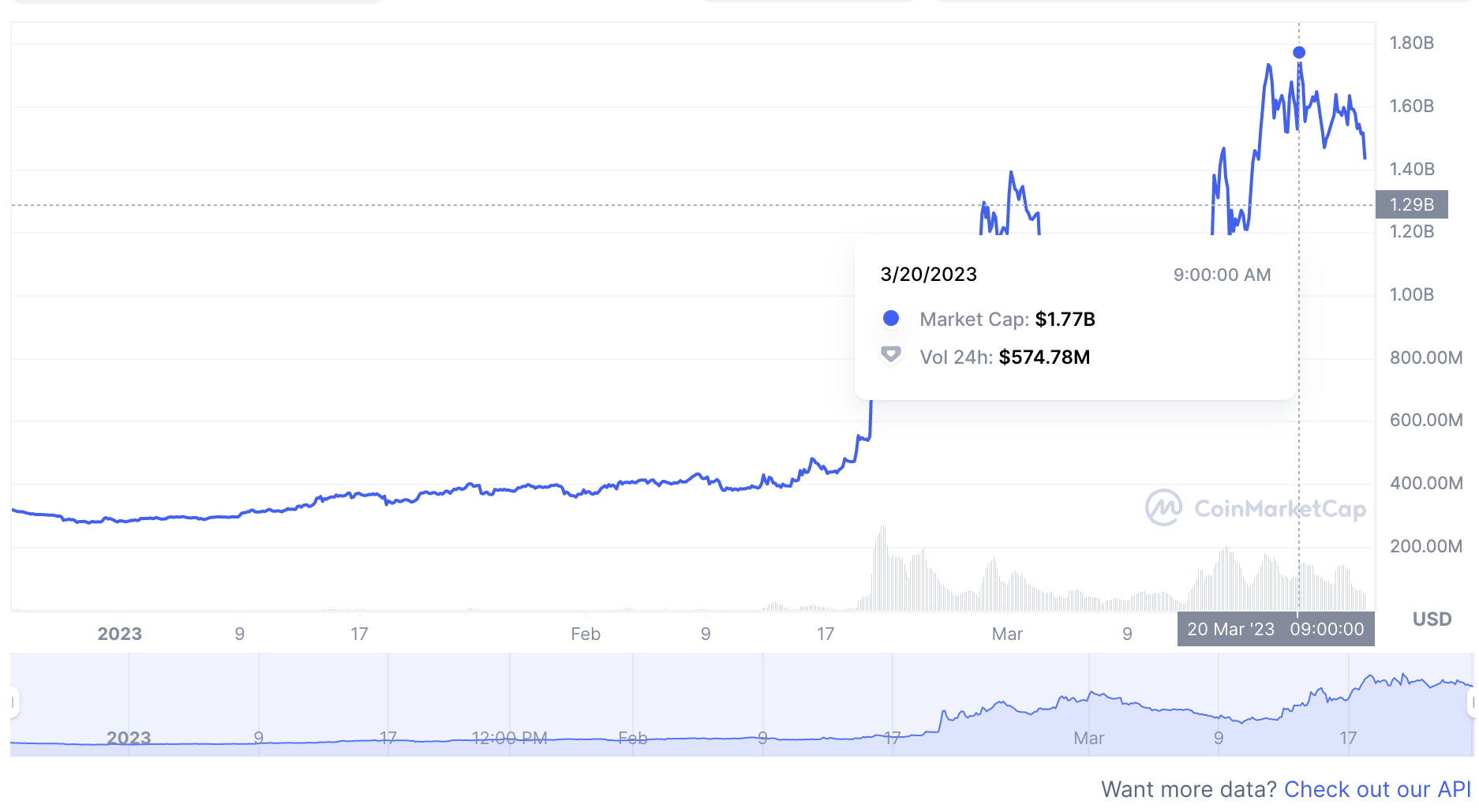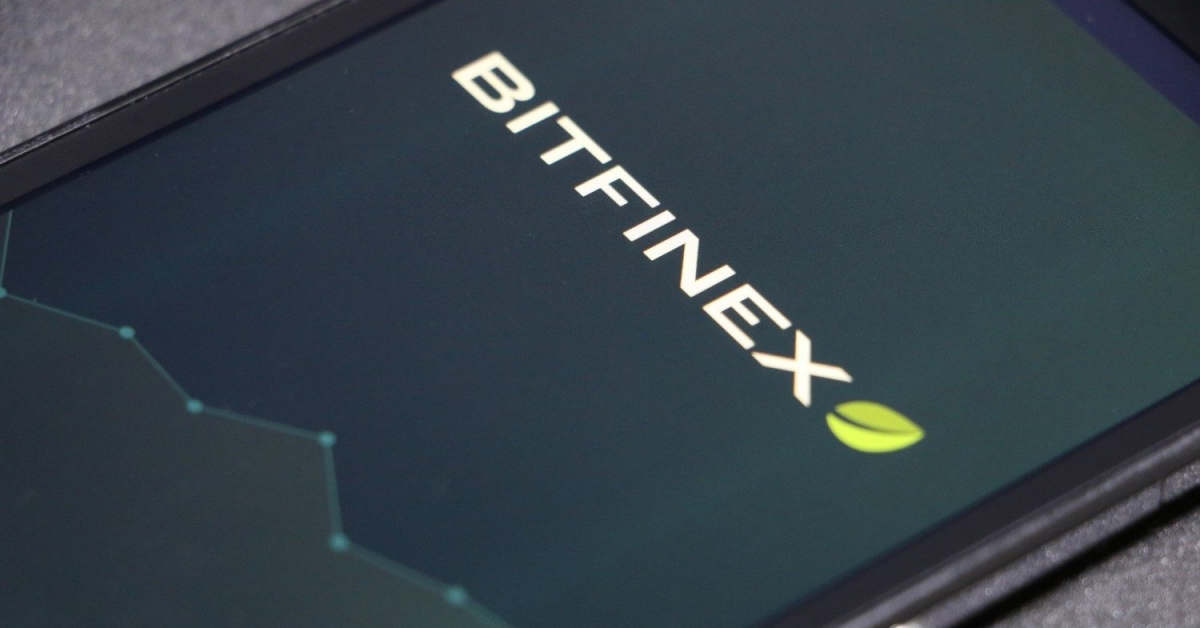Bitcoin Layer 2 Stacks’ Token a Top Performer in March
Stacks (STX), the native token of Stacks Network, has soared in March amid booming hype for Bitcoin Ordinals and growing total value locked (TVL) on the protocol. The project is also set to undergo an upgrade later this year to further speed and scalability.
Known for being the first token distributed through the first-ever U.S. Securities and Exchange Commission (SEC) qualified token offering in 2019, STX has gained 23% in March, reaching $1.25, the token’s highest level since a year ago. Although the token’s gains have slowed slightly toward the end of March, it is still up 350% over the last three months, bringing its valuation to $1.5 billion.
Looking at tokens with a market capitalization above $1 billion, STX is the second top-performing digital asset over the month of March, behind XRP, according to data from Messari.
Stacks is a Bitcoin layer 2 protocol for smart contracts that’s attempting to transform and extend Bitcoin’s functionality from its widely known role as an alternative payment system to a more versatile platform that is programmable.
The token began to climb last month amid market participants’ growing interest in creating Bitcoin Ordinal non-fungible tokens (NFT). Stacks has a native functionality to mint NFTs, and users have minted 650,000 Bitcoin NFTs on the Stacks layer 2, according to Stacks co-founder Muneeb Ali.
Stacks Network’s TVL also spiked over the last few months, climbing from $8 million in February to $35 million in mid-March, according to data from DeFiLlama. It has since retreated to $25 million.

(DeFiLlama)
“The hype surrounding Stacks is definitely due to Ordinals but could be sustained if the devs stick around,” decentralized finance (DeFi) analyst Michael Nadeau said. “Bitcoin needs projects like this to sustain itself in the long run.”
The Stacks smart contract protocol has a ledger to store data outside of Bitcoin’s layer 1, enabling developers to build apps on the platform, similar to what they can do on Ethereum or Solana.
Stacks is aiming to make Bitcoin more programmable, a feature more associated with the other two blockchain platforms, which currently have the majority of DeFi activity.
Stacks’ Ali said in an interview with CoinDesk that the recent interest surrounding STX could partly stem from anticipation for Stacks’ upcoming Nakamoto upgrade later this year.

Stacks’ market cap reached $1.7 billion in early March (CoinMarketCap)
He said the release will give users access to full smart contracts on a layer 2 chain, enabling them to move bitcoin (BTC) in and out while their layer 2 transactions are secured by the Bitcoin layer 1 network.
Ali said that unlike Ethereum and Arbitrum, users can’t easily move BTC into the Stacks layer right now. This is the biggest bottleneck.
The update is set to increase the network’s liquidity and capacity.
Ali also explained that unlike a lot of blockchains that require high-power hardware to run nodes, Stacks allows users to run nodes on less-sophisticated hardware such as Raspberry Pi or normal laptops, making it more accessible for users. Unlike Solana or ICP, Stacks doesn’t require you to run nodes in data centers, which is the typical way to deploy nodes with high hardware requirements, according to Ali.
In a report, NorthRock Digital, a hedge fund that invests in cryptocurrencies, wrote that “despite limitations developing a crypto economy on top of Bitcoin, Stacks has a potentially ‘massive opportunity’ … because of the relatively small crypto economy currently built on Bitcoin.
NorthRock identified three main layer 2 networks on Bitcoin: Lightning, RSK and Stacks. Each layer 2 “is complementary and has different goals, but of the three Stacks is furthest along in terms of developing an ecosystem for more traditional crypto applications (NFTs, DeFi, Name Services, etc.),” NorthRock wrote.
NorthRock also noted that Bitcoin’s upcoming halving will likely benefit Stacks. “The halving itself will decrease Bitcoin’s security budget and further reinforce the need to develop a larger fee pool through a more productive Bitcoin ecosystem. This will solidify the importance” of layer 2s like Stacks, the report said.
Edited by James Rubin and Stephen Alpher.
DISCLOSURE
Please note that our
privacy policy,
terms of use,
cookies,
and
do not sell my personal information
has been updated
.
The leader in news and information on cryptocurrency, digital assets and the future of money, CoinDesk is a media outlet that strives for the highest journalistic standards and abides by a
strict set of editorial policies.
CoinDesk is an independent operating subsidiary of
Digital Currency Group,
which invests in
cryptocurrencies
and blockchain
startups.
As part of their compensation, certain CoinDesk employees, including editorial employees, may receive exposure to DCG equity in the form of
stock appreciation rights,
which vest over a multi-year period. CoinDesk journalists are not allowed to purchase stock outright in DCG
.
:format(jpg)/www.coindesk.com/resizer/Nmp3uOLrfZuoxAeaCg5z6b27KoU=/arc-photo-coindesk/arc2-prod/public/S65B2QZAVNEBRBOGNCIVH5F7F4.png)
Lyllah Ledesma is a CoinDesk Markets reporter currently based in Europe. She holds bitcoin, ether and small amounts of other crypto assets.
Learn more about Consensus 2023, CoinDesk’s longest-running and most influential event that brings together all sides of crypto, blockchain and Web3. Head to consensus.coindesk.com to register and buy your pass now.
:format(jpg)/www.coindesk.com/resizer/Nmp3uOLrfZuoxAeaCg5z6b27KoU=/arc-photo-coindesk/arc2-prod/public/S65B2QZAVNEBRBOGNCIVH5F7F4.png)
Lyllah Ledesma is a CoinDesk Markets reporter currently based in Europe. She holds bitcoin, ether and small amounts of other crypto assets.









